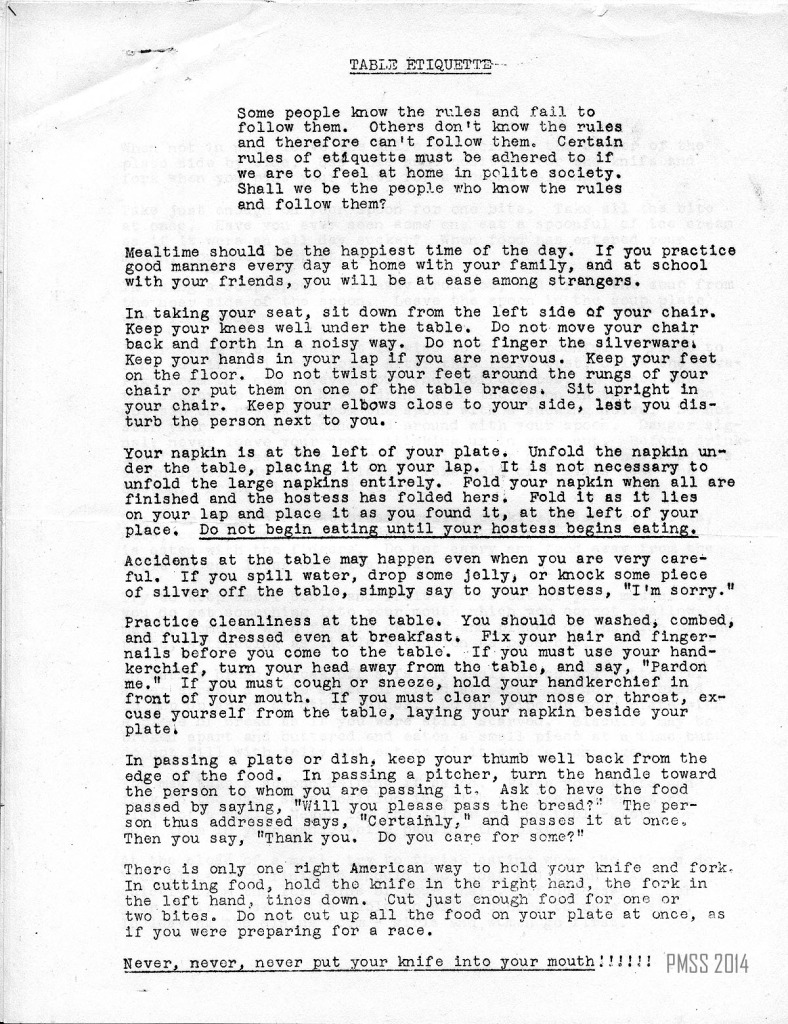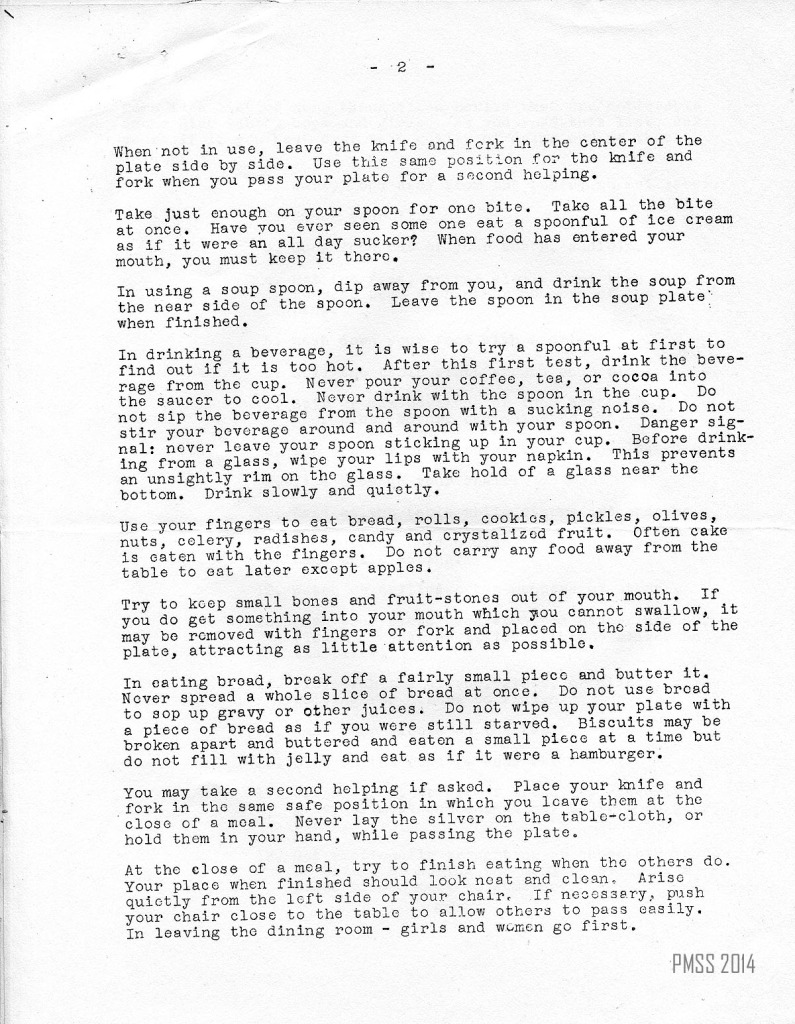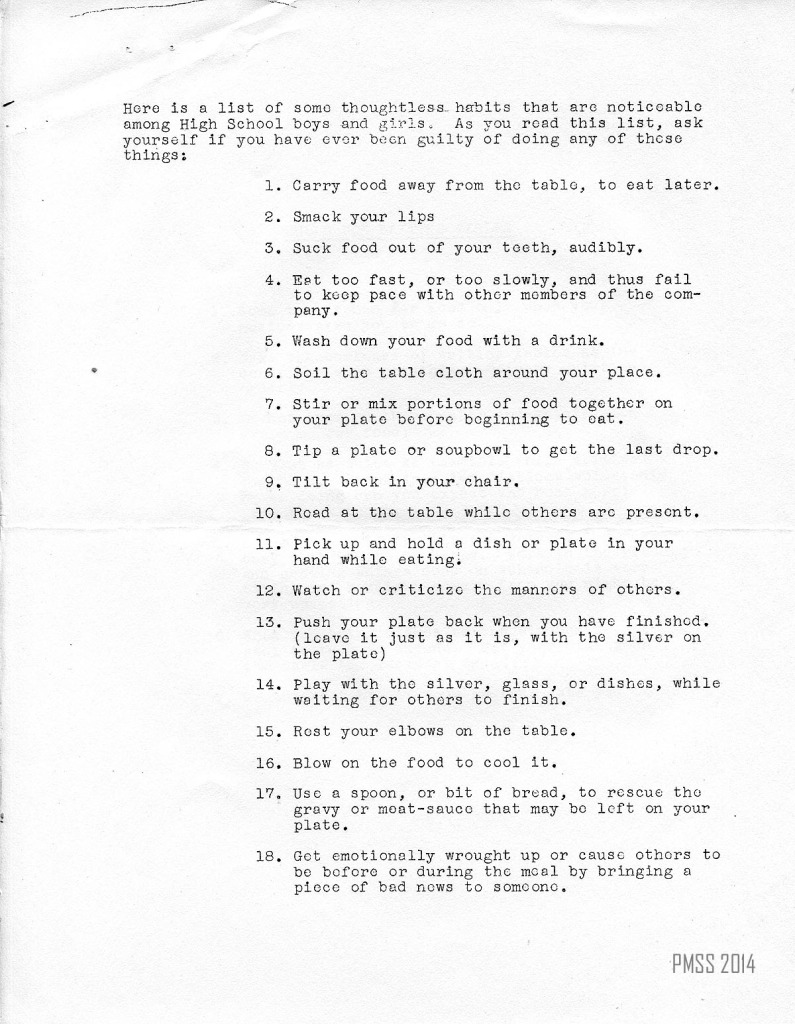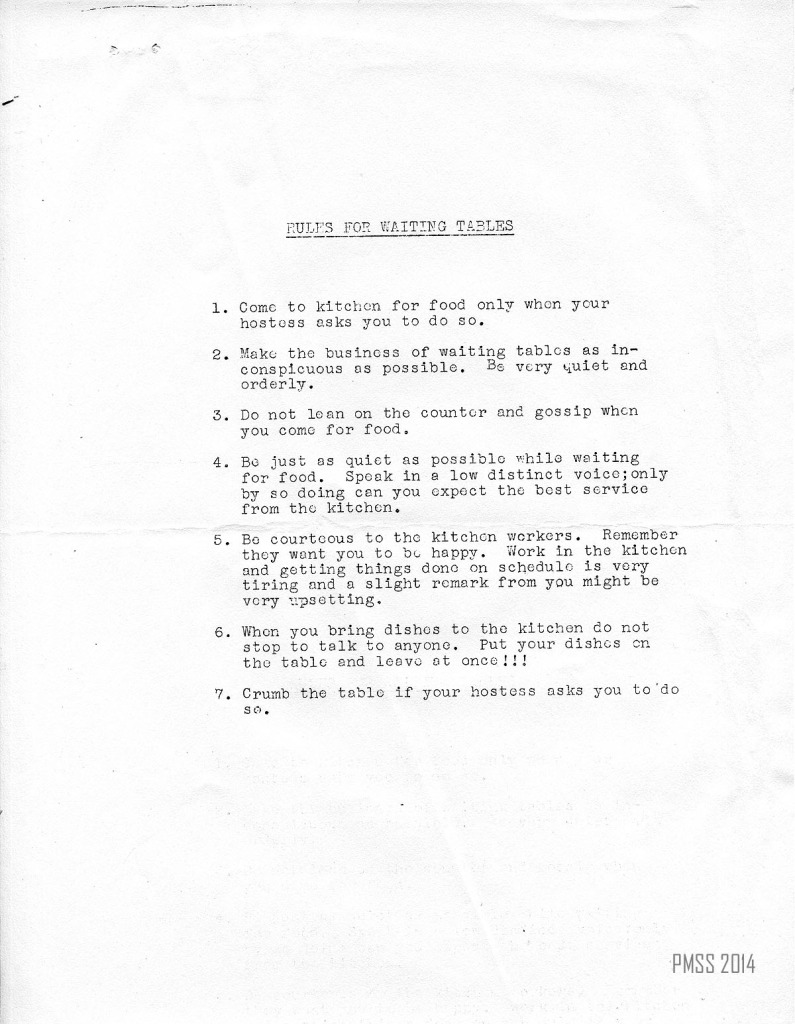Pine Mountain Settlement School
Series 07: ADMINISTRATIVE REGULATIONS
Table Etiquette and Dining Room Rules
(Boarding School)

Laurel House Dining Room. Boarding School years [nace_1_003b.jpg]
TAGS: Table Etiquette & Dining Room Rules, foodways, Birdena Bishop, dietitians, students, waiting tables, good manners, impolite habits, second helpings, use of a napkin, handling accidents, sitting properly, passing a plate,
ADMINISTRATIVE REGULATIONS Table Etiquette and Dining Room Rules (Boarding School)
Some people know the rules and follow them. Others don’t know the rules and therefore can’t follow them. Certain rules of etiquette must be adhered to if we are to feel at home in polite society, Shall we be the people who know the rules and follow them? …
While Birdena Bishop was dietitian at Pine Mountain Settlement School she continued the promotion of proper etiquette in the dining room. The following rules for dining etiquette during the Boarding School years and for those students who were charged with waiting tables are described in two publications produced in the late 1940s. It is likely that Birdena Bishop had a voice in the creation of these rules and regulations.
Contents: TABLE ETIQUETTE & DINING ROOM Rules
Pages 01 & 02.
Table etiquette ; reasons for good manners ; sitting at the table ; use of napkin ; handling accidents ; appearance & use of handkerchief ; passing a plate ; using knife, fork, spoon, soup spoon ; beverages ; when to use fingers ; eating bread ; second helping ; finishing and leaving ;
Page 03.
List of 18 impolite habits.
Page 04
Rules for waiting tables.
Gallery: TABLE ETIQUETTE & DINING ROOM Rules
-

Rules for Table Etiquette, page 01. [table_etiquette__001.jpg] -

Rules for Table Etiquette, page 02. [table_etiquette__002.jpg] -

Rules for Table Etiquette, page 03. [table_etiquette__003.jpg] -

Rules for Table Etiquette, page 04. [table_etiquette__004.jpg]
Transcription: TABLE ETIQUETTE & DINING ROOM Rules
Page 01. [table_etiquette__001.jpg]
TABLE ETIQUETTE
Some people know the rules and fail to follow them. Others don’t know the rules and therefore can’t follow them. Certain rules of etiquette must be adhered to if we are to feel at home in polite society. Shall we be the people who know the rules and follow them?
Mealtime should be the happiest time of the day. If you practice good manners every day at home with your family, and at school with your friends, you will be at ease among strangers.
In taking your seat, sit down from the left side of your chair. Keep your knees well under the table. Do not move your chair back and forth in a noisy way. Do not finger the silverware. Keep your hands in your lap if you are nervous. Keep your feet on the floor. Do not twist your feet around the rungs of your chair or put them on one of the table braces. Sit upright in your chair. Keep your elbows close to your side, lest you disturb the person next to you.
Your napkin is at the left of your plate. Unfold the napkin under the table, placing it on your lap. It is not necessary to unfold the large napkins entirely. Fold your napkin when all are finished and the hostess has folded hers. Fold it as it lies in your lap and place it as you found it, at the left of your place. Do not begin eating until your hostess begins eating.
Accidents at the table may happen even when you are very careful. If you spill water, drop some jelly, or knock some piece of silver off the table, simply say to your hostess, “I’m sorry.”
Practice cleanliness at the table. You should be washed, combed, and fully dressed even at breakfast. Fix your hair and fingernails before you come to the table. If you must use your handkerchief, turn your head away from the table, and say, “Pardon me.” If you must cough or sneeze, hold your handkerchief in front of your mouth. If you must clear your nose or throat, excuse yourself from the table, laying your napkin beside your plate.
In passing a plate or dish, keep your thumb well back from the edge of the food. In passing a pitcher, turn the handle toward the person to whom you are passing it. Ask to have the food passed by saying, “Will you please pass the bread?” The person thus addressed says, “Certainly,” and passes it at once. Then you say, “Thank you. Do you care for some?”
There is only one right American way to hold your knife and fork. In cutting food, hold the knife in the right hand, the fork in the left hand, tines down. Cut just enough food for one or two bites. Do not cut up all the food on your plate at once, as if you were preparing for a race.
Never, never, never put your knife into your mouth!!!!!
Page 02. [table_etiquette__002.jpg]
-2-
When not in use, leave the knife and fork in the center of the plate side by side. Use this same position for the knife and fork when you pass your plate for a second helping.
Take just enough on your spoon for one bite. Take all the bite at once. Have you ever seen some one eat a spoonful of ice cream as if it were an all day sucker? When food has entered your mouth, you must keep it there.
In using a soup spoon, dip away from you, and drink the soup from the near side of the spoon. Leave the spoon in the soup plate when finished.
In drinking a beverage, it is wise to try a spoonful at first to find out if it is too hot. After this first test, drink the beverage from the cup. Never pour your coffee, tea, or cocoa into the saucer to cool. Never drink with the spoon in the cup. Do not sip the beverage from the spoon with a sucking noise. Do not stir your beverage around and around with your spoon. Danger signal; never leave your spoon sticking up in your cup. Before drinking from a glass,
wipe your lips with your napkin. This prevents an unsightly rim on the glass. take hold of a glass near the bottom. Drink slowly and quietly.
Use your fingers to eat bread, rolls, cookies, pickles, olives, nuts, celery, radishes, candy and crystalized fruit. Often cake is eaten with the fingers. Do not carry any food away from the table to eat later except apples.
Try to keep small bones and fruit-stones out of your mouth. If you do get something into your mouth which you cannot swallow, it may be removed with fingers or fork and placed on the side of the plate, attracting as little attention as possible.
In eating bread, break off a fairly small piece and butter it. Never spread a whole slice of bread at once. Do not use bread to sop up gravy or other juices. Do not wipe up your plate with a piece of bread as if you were still starved. Biscuits may be broken apart and buttered and eaten a small piece at a time but do not fill with jelly or eat as if it were a hamburger.
You may take a second helping if asked. Place your knife and fork in the same safe position in which you leave them at the close of a meal. Never lay the silver on the table-cloth, or hold them in your hand, while passing the plate.
At the close of a meal, try to finish eating when the others do. Your place when finished should look neat and clean. Arise quietly from the left side of your chair. If necessary, push your chair close to the table to allow others to pass easily. In leaving the dining room — girls and women go first.
Page 03. [table_etiquette__003.jpg]
Here is a list of some thoughtless habits that are noticeable among High School boys and girls. As you read this list, ask yourself if you have ever been guilty of doing any of these things;
1. Carry food away from the table, to eat later.
2. Smack your lips.
3. Suck food out of your teeth, audibly.
4. Eat too fast, or too slowly, and thus fail to keep pace with other members of the company.
5. Wash down your food with a drink.
6. Soil the table cloth around your place.
7. Stir or mix portions of food together on your plate before beginning to eat.
8. Tip a plate or soup bowl to get the last drop.
9. Tilt back in your chair.
10. Read at the table while others are present.
11. Pick up and hold a dish or plate in your hand while eating.
12. Watch or criticize the manners of others.
13. Push your plate back when you have finished. (leave it just as it is, with the silver on the plate)
14. Play with the silver, glass, or dishes, while waiting for others to finish.
15. Rest your elbows on the table.
16. Blow on the food to cool it.
17. Use a spoon, or bit of bread, to rescue the gravy or meat-sauce that may be left on your plate.
18. Get emotionally wrought up or cause others to be before or during the meal by bringing a piece of bad news to someone.
Page 04. [table_etiquette__004.jpg]
RULES FOR WAITING TABLES
1. Come to kitchen for food only when your hostess asks you to do so.
2. Make the business of waiting tables as inconspicuous as possible. Be very quiet and orderly.
3. Do not lean on the counter and gossip when you come for food.
4. Be just as quiet as possible while waiting for food. Speak in a low distinct voice; only by so doing can you expect the best service from the kitchen.
5. Be courteous to the kitchen workers. Remember they want you to be happy. Work in the kitchen and getting things done on schedule is very tiring and a slight remark from you might be very upsetting.
6. When you bring dishes to the kitchen do not stop to talk to anyone. Put your dishes on the table and leave at once!!!
7. Crumb the table if your hostess asks you to do so.
Return To:
ADMINISTRATION GENERAL Rules and Regulations
See Also:
Series 18: RULES, REGULATION, POLICIES
ADMINISTRATION GENERAL PMSS Black Book
BIRDENA BISHOP Staff

